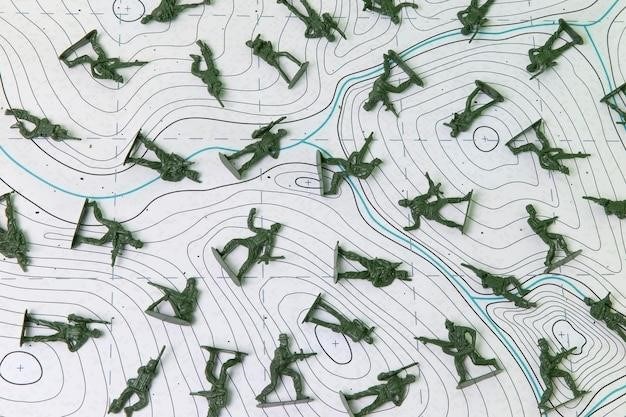
land warfare tactics pdf
Land Warfare Tactics⁚ A Comprehensive Overview
This overview explores the multifaceted nature of land warfare tactics, encompassing historical analysis, contemporary developments, technological impacts, and future projections. It examines evolving doctrines, case studies from diverse conflicts, and the crucial role of technology and information dissemination in shaping modern battlefield strategies. The text analyzes challenges in operational environments and the ongoing transformation of warfare.
Key Contemporary Developments in Land Warfare
Contemporary land warfare is characterized by several key developments. The increasing lethality and dispersion of forces necessitate innovative tactics emphasizing precision and volume of fire. Integrative technologies, such as networked systems and advanced sensors, are revolutionizing battlefield awareness and coordination. The importance of mass and effects, achieved through combined arms operations and synchronized actions, remains crucial. Simultaneously, invisibility and reduced detectability are paramount, driving the adoption of stealth technologies and asymmetric warfare strategies. These advancements demand adaptability in tactics, organization, doctrine, equipment, force composition, and command and control structures. The nature of conflict itself is evolving, with hybrid warfare and irregular combat requiring a diverse range of responses. Urban warfare presents unique challenges, necessitating specialized training and tactics. Furthermore, the growing significance of cyber warfare and information operations is transforming the strategic landscape, affecting planning and execution at every level. Finally, environmental considerations are increasingly integrated into tactical planning, recognizing the influence of terrain and climate on military operations.

Case Studies on Land Tactics and Operations
Analyzing specific conflicts provides valuable insights into the practical application and effectiveness of land warfare tactics. The recent conflicts in Ukraine, Syria, and Mali offer compelling case studies. In Ukraine, the Russian invasion highlighted the importance of combined arms warfare, but also the challenges posed by asymmetric warfare tactics and the effectiveness of defensive strategies against a larger, more technologically advanced foe. Syria’s civil war demonstrated the complexities of urban warfare and the devastating impact of protracted conflicts on civilian populations. The conflict in Mali showcases the challenges of counterinsurgency operations in difficult terrain and the difficulties in effectively combating sophisticated guerrilla tactics. These cases underscore the influence of factors like terrain, technology, and the nature of the opposing forces on tactical success. Further analysis of historical conflicts, such as the battles of Kursk or Normandy, reveals timeless principles of maneuver warfare and the enduring significance of effective command and control. Each case study offers unique lessons regarding the adaptation of tactics to specific circumstances and the importance of adapting to evolving threats and challenges on the modern battlefield.
NATO Doctrine for Allied Land Tactics
NATO’s approach to allied land tactics emphasizes interoperability and standardization across member nations. The doctrine prioritizes combined arms operations, integrating maneuver, fire support, and intelligence to achieve decisive results. Key principles include the importance of adapting tactics to the specific operational environment, utilizing technological advantages, and maintaining robust command and control structures. NATO doctrine stresses the need for clear planning and execution, emphasizing mission command principles that empower subordinate commanders to adapt to changing circumstances while maintaining overall operational cohesion. The alliance’s tactical doctrine continually evolves to adapt to emerging threats and advancements in military technology, incorporating lessons learned from past conflicts and ongoing operational experiences. Emphasis is placed on effective training and exercises to ensure that allied forces can seamlessly integrate their capabilities and effectively execute complex operations in a variety of challenging scenarios. This ensures a unified approach to land warfare within the NATO framework.
The Evolving Role of Land Forces
The role of land forces is undergoing a significant transformation in the 21st century. While retaining their core function of securing and controlling territory, land forces are increasingly integrating with other domains, such as air and cyber warfare. This necessitates a shift towards more flexible and adaptable operational concepts. The increasing prevalence of asymmetric warfare and hybrid threats requires land forces to develop new capabilities for countering unconventional tactics, including robust information operations and advanced intelligence gathering. Technological advancements, such as unmanned systems and precision-guided munitions, are reshaping the battlefield, demanding new training and doctrinal adjustments for effective utilization. Furthermore, the emphasis on expeditionary operations and rapid deployment necessitates a focus on lighter, more mobile forces capable of operating effectively in diverse and challenging environments. The evolving geopolitical landscape necessitates a renewed focus on interoperability and combined arms operations, fostering collaborative efforts with allies and partners to address shared security concerns. This evolving role requires a constant adaptation of training, doctrine, and technology to maintain effectiveness in an ever-changing global security environment.
Impact of Technology and Information Dissemination
Technological advancements profoundly impact modern land warfare tactics. Precision-guided munitions, enhanced surveillance systems, and unmanned aerial vehicles (UAVs) drastically increase the lethality and accuracy of attacks while minimizing collateral damage. Network-centric warfare, enabled by advanced communication systems, allows for real-time information sharing across units, improving coordination and decision-making. However, this interconnectedness also creates vulnerabilities to cyberattacks and electronic warfare, necessitating robust cybersecurity measures. The proliferation of readily available information and social media presents both opportunities and challenges. While effective information dissemination can boost morale and public support, it can also be exploited by adversaries for propaganda and disinformation campaigns. Artificial intelligence (AI) is increasingly integrated into military systems, enhancing situational awareness, targeting capabilities, and autonomous operations. Yet, ethical considerations and potential biases within AI algorithms must be carefully addressed. The rapid pace of technological change necessitates continuous adaptation of doctrine, training, and equipment to maintain a decisive advantage on the battlefield. Maintaining technological superiority remains crucial for success in modern land warfare.
Challenges in the Operational Environment

The modern operational environment for land warfare presents numerous complex challenges. Urban warfare, with its inherent complexities of dense populations and confined spaces, demands specialized tactics and equipment. Asymmetric warfare, where non-state actors employ unconventional tactics, poses significant difficulties in terms of intelligence gathering and target identification. The increasing prevalence of hybrid warfare, which blends conventional and unconventional methods, further complicates strategic planning and execution. Maintaining the security of supply lines and logistics in hostile or contested environments remains a critical concern. The ethical implications of using lethal autonomous weapons systems (LAWS) require careful consideration. The growing sophistication of anti-access/area denial (A2/AD) capabilities, such as advanced air defense systems and precision-guided munitions, presents significant challenges to offensive operations. Effective coordination and collaboration among different branches of the military (joint operations) are crucial to success, particularly in complex, multi-domain environments. Adapting to rapidly evolving threats and technological advancements requires continuous learning, training, and refinement of doctrines and tactics. Successfully navigating these challenges demands flexibility, adaptability, and a deep understanding of the human dimension of conflict.
Future Character of War and Battlefield Transformation
Forecasting the future character of war is inherently challenging, yet several trends suggest significant transformations in land warfare. The increasing integration of artificial intelligence (AI) and autonomous systems will likely revolutionize battlefield decision-making and the conduct of operations. Expect to see greater reliance on robotic and unmanned platforms for reconnaissance, surveillance, and even direct combat roles. Cyber warfare will continue to play a more prominent role, potentially disrupting command and control systems, logistics, and even the functioning of civilian infrastructure. The blurring of lines between conventional and unconventional warfare will persist, with state and non-state actors employing hybrid tactics. Information warfare will become even more critical, with the potential for widespread disinformation campaigns to influence public opinion and erode trust in institutions. The increasing lethality and precision of long-range weaponry will necessitate new strategies for force protection and maneuver. The proliferation of advanced sensors and data analytics will enhance situational awareness, but also necessitate greater cybersecurity measures to prevent data breaches and manipulation. The development of new materials and technologies could lead to the emergence of innovative weapons and defensive systems, altering the balance of power on the battlefield. Finally, the increasing interconnectedness of global systems and the potential for cascading effects from attacks on critical infrastructure will create additional challenges for military planners and commanders.
Analysis of Historical Tactics and Strategies
Analyzing historical land warfare tactics and strategies offers invaluable insights into the enduring principles and evolving nature of combat. From ancient phalanx formations to modern combined arms operations, a recurring theme is the adaptation of tactics to technological advancements and evolving geopolitical landscapes. Studying historical battles, such as Cannae or Waterloo, reveals the importance of terrain, logistics, and effective leadership in achieving victory. The evolution of military doctrine, from linear tactics to maneuver warfare, demonstrates the continuous search for effective ways to overcome the enemy. The impact of technological innovations, such as gunpowder, machine guns, and tanks, fundamentally altered the conduct of warfare, forcing constant adaptation in tactics and strategies. Analysis of past conflicts illuminates the critical role of intelligence gathering, deception, and psychological operations in achieving strategic objectives. Furthermore, examining historical case studies allows for the identification of both successful and failed approaches, providing valuable lessons for contemporary military planners. Understanding the successes and failures of past strategies is essential for developing effective tactics and doctrines for future conflicts. This historical perspective offers a crucial foundation for understanding the dynamics of modern land warfare and informing future strategic decisions.
Modern Land Warfare Tactics and Procedures
Modern land warfare tactics and procedures are characterized by a complex interplay of technological advancements, doctrinal innovations, and evolving operational environments. Network-centric warfare, emphasizing seamless information sharing and coordinated actions across multiple domains, has become a cornerstone of modern military operations. Precision-guided munitions, advanced surveillance technologies, and unmanned aerial vehicles (UAVs) significantly enhance battlefield awareness and targeting capabilities. Combined arms operations, integrating infantry, armor, artillery, and air support, remain crucial for achieving decisive results. Asymmetric warfare, characterized by irregular combatants and unconventional tactics, poses unique challenges requiring adaptability and unconventional responses; Urban warfare, with its complex environments and close-quarters combat, necessitates specialized training and tactics. Cyber warfare’s integration into land operations adds another dimension, impacting command and control, intelligence gathering, and logistics. The increasing prevalence of hybrid warfare, combining conventional and unconventional tactics, necessitates a flexible and adaptable approach to doctrine and operational planning. Furthermore, the human element remains critical, demanding rigorous training and emphasis on leadership, adaptability, and resilience in the face of ever-evolving challenges.
Lessons Learned from Recent Conflicts
Recent conflicts have provided invaluable insights into the evolving dynamics of modern land warfare. The importance of adaptability and responsiveness to asymmetric threats has been highlighted, showcasing the limitations of purely conventional approaches against unconventional warfare tactics. The effectiveness of combined arms operations, integrating diverse military capabilities for synergistic effects, has been repeatedly demonstrated. The increasing significance of information dominance and cyber warfare in shaping battlefield outcomes has become evident. The crucial role of logistics and sustainment in prolonged conflicts has been underscored, emphasizing the need for robust supply chains and effective resource management. The limitations of relying solely on technological superiority, highlighting the enduring importance of human factors like training, leadership, and morale, have also emerged. Furthermore, the impact of urban warfare on both tactical and strategic levels has been clearly illustrated, necessitating the development of specialized tactics and equipment for close-quarters combat in dense urban environments. The critical need for robust intelligence gathering and analysis, to inform decision-making and adapt to evolving threats, has been consistently emphasized. Finally, the long-term consequences of conflict, including the humanitarian crisis and the need for effective post-conflict stabilization strategies, have also been brought to the forefront.
The Future of Land Warfare Tactics
The future of land warfare tactics will be shaped by several key trends. The increasing integration of autonomous systems and artificial intelligence will lead to significant changes in battlefield decision-making and operational tempo. The rise of hypersonic weapons and precision-guided munitions will necessitate the development of new defensive strategies and tactics to counter their speed and accuracy. The continued proliferation of cyber warfare and information operations will demand enhanced cyber defenses and the ability to effectively counter misinformation campaigns. The growing importance of space-based assets for intelligence, surveillance, and reconnaissance will influence tactical planning and execution. The need for greater interoperability and joint operations, seamlessly integrating land forces with air, sea, and space assets, will become paramount. Furthermore, the ethical implications of increasingly autonomous weapons systems will require careful consideration and the establishment of clear rules of engagement. The potential for the use of novel technologies, such as directed energy weapons and advanced robotics, will present both opportunities and challenges for future tactical doctrine. Finally, the evolving geopolitical landscape and the rise of new forms of conflict, such as hybrid warfare, will necessitate adaptable and flexible tactics to respond to a wide spectrum of threats.
